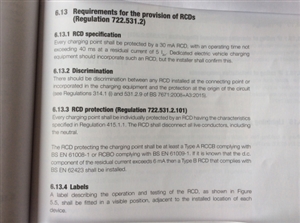OlympusMons:
Hi Graham, I don't own a copy of bs1363-2 and was unaware of clause 7.1(b). However my point was that the quoted reg is unclear. If it meant that the socket outlet should have bs1363/EV printed on its rear by the OEM, then that is what it should say. not "a socket outlet complying with bs1363-2 marked "EV" on its rear"
I guess whatever the case, anything that's written could be misinterpreted. The wording of 722.55.101.0.201.1 has been in place since 2018 for the 18th Edition, although there was an opportunity for everyone to comment on it for quite some period back in October 2019, when Amendment 1 DPC was in place.
The same reg says an additional label shall be provided on the "front face" which is what I was referring to at the start of the above post. It does say "except where there is no possibility of confusion" and I apologise if my post caused any.
OlympusMons:
Chris Pearson:
...
But we are getting away from JP's OP. ..
Apologies John.

We're about to take you to the IET registration website. Don't worry though, you'll be sent straight back to the community after completing the registration.
Continue to the IET registration site